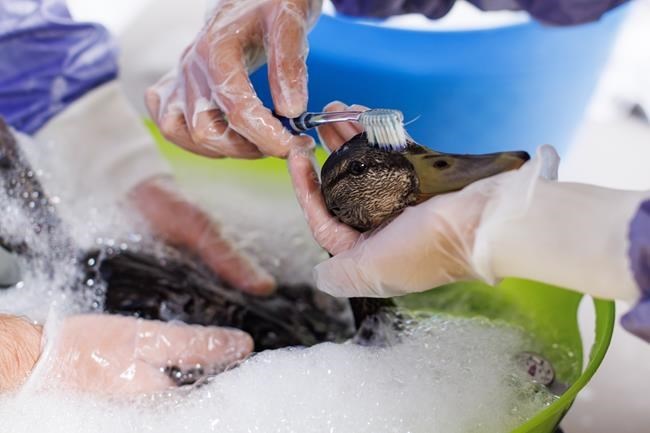TORONTO — Days after runoff from an industrial fire in west Toronto contaminated two nearby creeks, workers at the Toronto Wildlife Centre rub, scrub and massage soap into nearly 90 ducks one by one in sudsy tubs.
The charitable wildlife rescue says thousands of fish, a beaver, 10 ducks and a mink have died following a six-alarm fire at Brenntag Canada,a chemical distribution facility that blends lubricating oils last week.
But the centre has found 86 other ducks — as well as two cooper's hawks — around the Mimico and Humber creeks, covered in oily residue, and are now trying to clean the waterfowl.
Nathalie Karvonen, executive director of Toronto Wildlife Centre, says once residue-covered ducks are captured, a medical exam is done and the animals are tubed with activated charcoal and fluids down their throat to help counteract the toxins they have already ingested.
Once stable, they are bathed in soap and water using a toothbrush and hose to get rid of thepotentiallytoxic substances on their feathers.
“(The birds') feathers in nature are designed to be perfectly waterproofed to not let any water through, so that underneath the exterior feather they are nice, dry and warm,” Karvonen says.
“If they are not waterproof the water will get through to their skin and (they will) get hypothermia, which is life threatening to them.”
Once the ducks are healthy and waterproof again, Karvonen says the goal is to release them back into their habitat once the area has been cleaned.
The Ontario Ministry of the Environment, Conservation and Parks says cleanup and containment efforts of the contaminatedwater are underway including placing booms, haybales, installing underflow dams, deploying vacuum trucks to collect the oil slurry and diverting discharge from any further release into the creeks.
Testing to determine what ended up in the creek and on the birds is in progress.
Animal rescue crews have been on scene everyday, Karvonen says, noting the number of animals killed due to contaminants will never be known. Herons have also been seen eating the dead fish, while deer have been spotted drinking the contaminated water.
The ministry says staff have been on site since the Aug. 11 incident, monitoring the situation with the city of Toronto water department, Brenntag Canada and its spill cleanup contractor.
“A light sheen has been observed at the mouth of Mimico Creek to Lake Ontario," the ministry said in a statement.
"Operators from the city of Toronto water treatment plants are aware…Currently, there have been no concerns of impacts to the municipal water supply identified."
Runoff has not reached the Humber River, the ministry said.
The wildlife centre is urging anyone who sees an animal in the area covered in residue, distressed or sick to not feed or capture them, and instead call their hotline and report the animal.
This report by The Canadian Press was first published Aug. 18, 2023.
Nairah Ahmed, The Canadian Press




